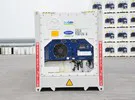Suboptimal transport conditions and equipment play a significant role in food wastage; upgrading refrigerated equipment with telematics can be a realistic, sustainable part of the solution.
It is estimated that 1.3 billion metric tons of food are lost or wasted annually, translating to a financial loss of $1 trillion (USD) per year. And without significant changes, this problem is expected to grow to 2.1 billion metric tons and $1.5 trillion (USD) by 2030.
Staggering as these numbers might be, they do not take into account the hidden costs of food production, including labor, storage and salvage or the costs related to customer dissatisfaction, lost opportunities, and inventory/stocking level imprecision.
Shockingly, one-third of all food produced for human consumption is lost due to wastage, which not only has significant financial implications, but also has environmental and social implications as well.
The commodities with the highest level of waste:
with the highest level of waste:
- Fruits and vegetables (45%)— equivalent to 3.7 trillion apples
- Roots and tubers (45%) – equivalent to 1 billion bags of potatoes
- Fish and seafood (35%) – equivalent to 3 billion Atlantic salmon
- Meat (20%) – equivalent to 75 million cows
Food waste and loss is pervasive throughout the entire food value chain – from farm to fork as they say. Harvesting, manufacturing, packaging, transporting and stock rotation as well as the consumers’ tendency to overbuy all contribute to excessive waste and spoilage.
While there are a lot of variables impacting food wastage, approximately 7-15% of the wastage happens during transport. There are many factors that could impact the inside temperature of a container – fluctuating regional outside temperatures throughout the chain, how full the container is, or even the opening of a container door. Even at 40 degrees Fahrenheit, food quality can begin to deteriorate, and bacteria can begin to grow in just one hour.
As the leading refrigerated equipment lessor, SeaCube understands the importance of optimizing equipment and utilizing technology to mitigate perishable wastage occurring during transport. Every Carrier reefer in the SeaCube fleet will be equipped with the Carrier Lynx Fleet Management solution, which will provide enhanced visibility to show where the container is, how it is performing as well as what is happening inside the container.
the leading refrigerated equipment lessor, SeaCube understands the importance of optimizing equipment and utilizing technology to mitigate perishable wastage occurring during transport. Every Carrier reefer in the SeaCube fleet will be equipped with the Carrier Lynx Fleet Management solution, which will provide enhanced visibility to show where the container is, how it is performing as well as what is happening inside the container.
The Carrier Lynx Fleet solution includes proprietary technology that monitors reefer unit performance and provides early warning actionable diagnostics and predictive analytics down to the level of the machine’s components. Lynx Fleet will offer prognostics and data analytics on Carrier and non-Carrier equipment with features that provide differentiation such as improved fleet uptime, reduced operational costs and incremental value through lower cargo spoilage.
For more information:
SeaCube Containers
123 Tice Boulevard
Woodcliff Lake, NJ 07677
Tel: +1 201-391-0800
seacubecontainers.com
